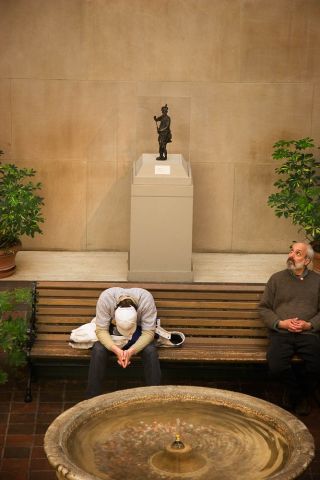Cognition
Your Brain on Art: Enhancing Neuropsychological Capabilities
How art stimulates your brain to make it better.
Posted February 12, 2024 Reviewed by Monica Vilhauer
Key points
- Art is a catalyst for enhancing brain function and mental health.
- It bolsters observation skills and analytical thinking.
- It has the capacity to enhance empathy and improve memory.
- Viewing art can lessen stress and induce feelings of relaxation.

Collectors collect art, which, in turn, serves as a powerful catalyst for enhancing brain function and mental health. Here, I explore the mechanisms that underlie this process, supported by academic research and hypothetical frameworks.
Firstly, interpreting visual art requires the brain to analyze complex visual stimuli, recognize patterns, and decipher concepts. This examination can bolster observation skills and analytical thinking (Zeki, 1999). Further, viewing art can enhance critical thinking (Bolwerk et al., 2014). Neuroimaging studies also support this type of cognitive engagement. They reveal increased activity in brain areas associated with visual processing and interpretation when individuals are exposed to art (Kawabata and Zeki, 2004).
Secondly, since art conveys emotion, it has the capacity to enhance empathy. Rezaei et al. (2023) recently reported that art education increases empathy among medical students. Confirmatory evidence was demonstrated earlier as well. Mangione et al. (2018) found that exposure of medical students to art “empirically confirms what many have intuitively suspected for years: exposure to the humanities is associated with both important personal qualities (tolerance of ambiguity, empathy, and wisdom) and prevention of burnout.”
Thirdly, viewing art can lessen stress and induce feelings of relaxation. Ulrich et al. (1991) reported that exposure to aesthetically pleasing visual art lowered cortisol, a significant stress hormone. At the same time, brain activity would be expected to shift from stress-prone regions to those associated with pleasure and relaxation.
Fourthly, even memory can be improved when engaging with art. Recalling historical context, personal experiences, or specific details about the artwork exercises the brain's memory functions. Bone et al. (2023) found that receptive art (viewing art as opposed to participating in it) can enhance memory. This would involve brain regions such as the hippocampus, which is critical for memory processing.
Lastly, art appreciation often occurs within social contexts, such as collector's homes, museums and galleries. In these venues, discussions about art can improve communication skills and foster social connections (Perkins et al., 2021). Thus, the shared art experience can facilitate deeper understanding and communication among individuals who participate in art appreciation. This highlights the social benefits of the arts.
Summary
In conclusion, art appreciation extends beyond aesthetic enjoyment, significantly impacting brain function and mental health. Through cognitive enhancement, stress reduction, memory improvement, and social connectivity, art appreciation emerges as a valuable tool for fostering mental well-being and cognitive resilience. The body of academic research supporting these benefits underscores its importance to collectors when they collect art and how necessary it is to integrate art and cultural experiences into daily life and educational curricula to harness these positive outcomes.
References
Zeki, S. (1999). Inner Vision: An Exploration of Art and the Brain. Oxford and New York: Oxford University Press.
Bolwerk, A., Mack-Andrick, J., Lang, F. R., Dörfler, A., & Maihöfner, C. (2014). How art changes your brain: Differential effects of visual art production and cognitive art evaluation on functional brain connectivity. PLOS ONE, 9(7), e101035.
Kawabata, H., & Zeki, S. (2004). Neural correlates of beauty. Journal of Neurophysiology, 91(4), 1699-1705.
Rezaei, S., Childress, A., Kaul, B., Rosales, K. M., Newell, A., & Rose, S. (2023). Using Visual Arts Education and Reflective Practice to Increase Empathy and Perspective Taking in Medical Students. MedEdPORTAL: The Journal of Teaching and Learning Resources, 19. https://doi.org/10.15766/mep_2374-8265.11346
Ulrich, R. S., Simons, R. F., Losito, B. D., Fiorito, E., Miles, M. A., & Zelson, M. (1991). Stress recovery during exposure to natural and urban environments. Journal of Environmental Psychology, 11(3), 201-230. https://doi.org/10.1016/S0272-4944(05)80184-7
Jessica K. Bone, Daisy Fancourt, Jill K. Sonke & Feifei Bu (2023) Participatory and Receptive Arts Engagement in Older Adults: Associations with Cognition Over a Seven-Year Period, Creativity Research Journal, DOI: 10.1080/10400419.2023.2247241
Perkins, R., Mason-Bertrand, A., Tymoszuk, U. et al. (2021) Arts engagement supports social connectedness in adulthood: findings from the HEartS Survey. BMC Public Health 21, 1208. https://doi.org/10.1186/s12889-021-11233-6
Mangione, S., Chakraborti, C., Staltari, G. et al. Medical Students’ Exposure to the Humanities Correlates with Positive Personal Qualities and Reduced Burnout: A Multi-Institutional U.S. Survey. J GEN INTERN MED 33, 628–634 (2018). https://doi.org/10.1007/s11606-017-4275-8


